Stimulus & extra UI dried up. But 16% of “proprietors’ income” in October was PPP money & Pandemic farm aid.
By Wolf Richter for WOLF STREET.
Consumers are running low on artificial steam – meaning stimulus money, extra unemployment benefits, money from rents-not-paid and from mortgage-payments-not-made, though they still get a lot of money from cash-out mortgage refis at historically low interest rates. And consumers are still spending record amounts on durable goods, a lot of them imported, but cut back on nondurable goods. And spending on services – plane tickets, hotels, healthcare, rent, etc. – are still deep in the hole.
Personal income.
Personal income from all sources in October ticked down 0.7% from September, to a seasonally adjusted annual rate of $19.7 trillion, according to the Bureau of Economic Analysis today. It was down 6.9% from its fabulous stimulus-and-unemployment-money-induced spike in April. But it’s still up 5.5% from a year ago, which makes this, during the Pandemic when over 20 million people are still claiming state or federal unemployment benefits, the Weirdest Economy Ever:
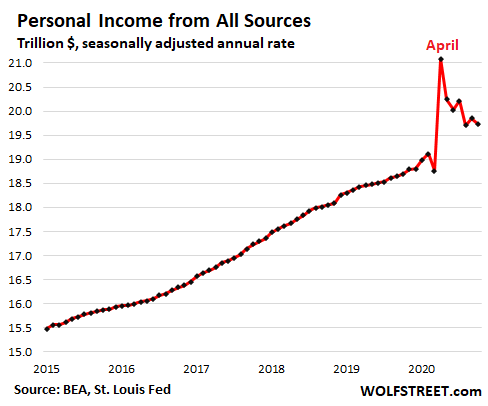
The personal income and spending numbers released by the BEA are “annual rates,” a hypothetical concoction that extrapolates the amount of the current month out to an entire year, essentially multiplying the current month figure by 12. So no, consumers didn’t make $19.7 trillion in October. That was the “annual rate.” And it was seasonally adjusted too. To illustrate: the actual personal income in all of 2019 was $18.5 trillion, or $1.54 trillion on average per month.
Free Pandemic Money Runs Low.
Income from unemployment insurance (UI) had skyrocketed from an annual rate of $28 billion received by consumers in February to an annual rate of $1.40 trillion in June, fired up by the extra $600-a-week in federal unemployment benefits, which expired at the end of July. While backlogs saw to it that payments were still being processed in the following months, the amounts of UI received began to plunge. And in October, it fell to $306 billion (annual rate), the lowest since March.
Stimulus & welfare payments – the $1,200 per adult and $500 per child – started arriving in bank accounts in April. The BEA adds these stimulus payments to the regular and fairly steady welfare and other government payments (for short, “welfare payments”). Those welfare payments amounted to $506 billion (annual rate) in February, before there was any stimulus. Then in April, stimulus payments of $2.86 trillion (annual rate) flooded consumer bank accounts, and combined with welfare payments amounted to $3.38 trillion (annual rate).
By October, most of the stimulus payments had dried up (deadline had been extended to November 21 for the stragglers the IRS has a hard time finding). And the welfare and stimulus payments dropped to $732 billion (annual rate).
UI, stimulus, and welfare combined, after spiking to an annual rate of $3.88 trillion in April, fell to $1.04 trillion in October:
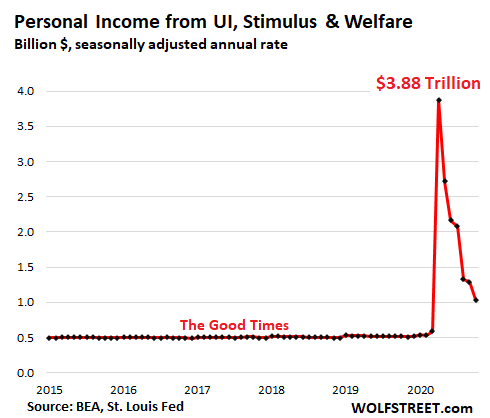
Money from wages and salaries.
Personal income from wages and salaries, including from self-employment activities, rose 0.7% in October from September to an annual rate of $9.58 trillion. This was still down 0.9% from February, the last month of the Good Times, but it was up 2.1% from a year ago. This is income “in aggregate,” all added together, including those at the top of the income scale with multi-million-dollar increases in annual incomes:
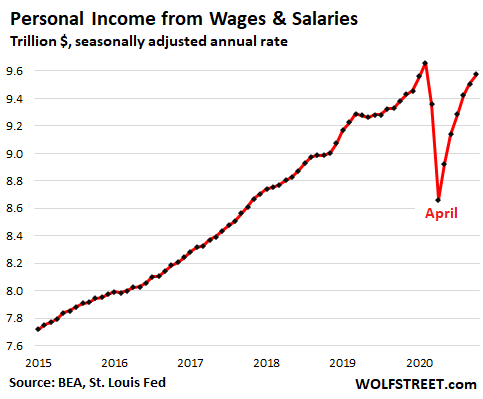
The chart below shows by how much the stimulus and extra unemployment benefits overshot the drop in income from wages and salaries, which is in part what triggered the Weirdest Economy Ever:
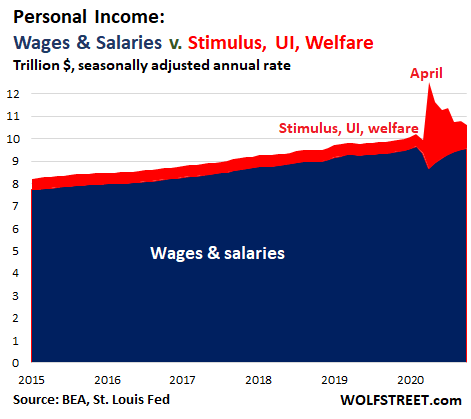
Personal income from other sources, October v. the Good-Times February:
Proprietors’ income (farm and nonfarm) rose by 17.5% from February, to $1.92 trillion (annual rate). This includes, you guessed it…
Free Pandemic-money for proprietors: $302 billion (annual rate) of proprietors’ income in October, or nearly 16% of total proprietors’ income, was provided by Pandemic aid programs:
- “Coronavirus Food Assistance Program” for farms added $93 billion (annual rate)
- “Paycheck Protection Program loans” (PPP) for farms added $6.3 billion (annual rate)
- PPP for nonfarms added $203 billion (annual rate).
Supplements to wages and salaries – employer contributions to employee benefits, pensions, and social insurance – at $2.15 trillion (annual rate) are down just 0.6% from February.
Interest and dividend income fell by 3.6% from February – thanks to the Fed’s interest rate repression and corporate dividend cuts – to $2.88 trillion (annual rate).
Rental income rose by 2.0% from February to $818 billion (annual rate).
Government transfer payments via Social Security, Medicare, Medicaid, and Veterans’ benefits rose 5.0% from February to $2.76 trillion (annual rate).
Medicare and Medicaid payments are counted in personal income because individuals are the beneficiaries though healthcare providers received the payments. The sharp increase in those two and in the payments to Veterans are at least in part a function of the costs of treating Covid patients:
- 2.4% increase in Social Security benefits (to $1.09 trillion annual rate)
- 6.1% increase in Medicare payments (to $854 billion annual rate, paid to providers)
- 7.7% jump in Medicaid payments (to $669 billion annual rate paid to providers)
- 6.2% jump in Veterans’ benefits (to $147 billion annual rate).
Where did consumers spend this moolah?
Consumers still went nuts over durable goods, but cut back on nondurable goods and continued to scrimp on the biggie, services.
Total consumer spending in October ticked up 0.5% from September to $14.64 trillion (annual rate), but was still down 1.6% from Good-Times February and down 0.6% from a year ago:
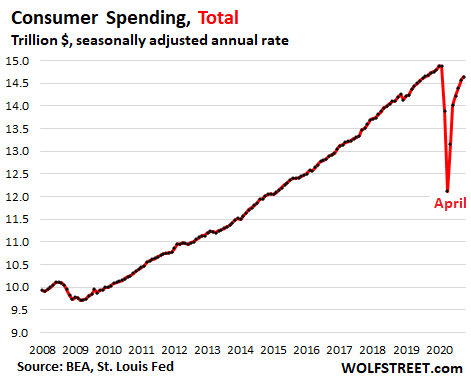
None of the spending data is adjusted for inflation, and in some categories there have been big price increases, including historic 15% price increase for used vehicles over the three-month period July, August, and September.
Spending on durable goods added a tad to the crazy spike – many of these products are imported from China, Germany, Japan, Mexico, etc., and they’re all very grateful for the stimulus – as consumers are splurging on laptops, other electronic devices, expensive vehicles, furniture, appliances, and the like.
But the increase in October, +0.6% from September, was the smallest month-to-month increase since April. At $1.79 trillion (annual rate), spending was up by 15% from Good-Times February and from a year ago:
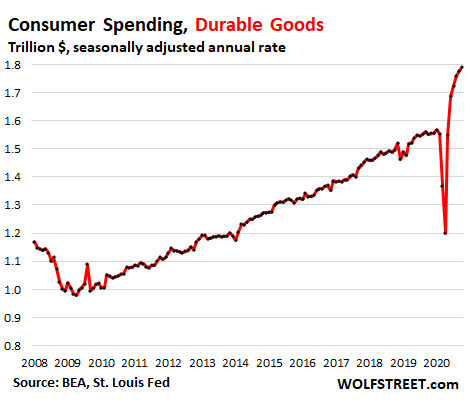
Spending on nondurable goods ticked down by 0.3% in October from September, to $3.14 trillion (annual rate), the first month-to-month decline since April, but was still up 4.0% from February and 4.2% from a year ago:
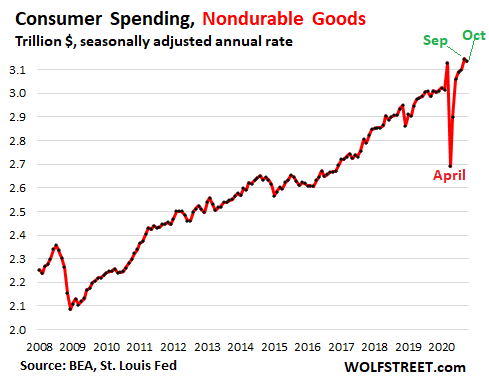
And the biggie, spending on services – which include rents (so if more people than normal don’t make their rent payments…), healthcare, insurance, airplane tickets, lodging, haircuts, broadband and cellphone subscriptions, utilities, etc., accounting for about two-thirds of total consumer spending – inched up a mere 0.7% in October from September, to $9.72 trillion (annual rate), the smallest increase since April, and remain 5.8% below February and 4.4% below a year ago:
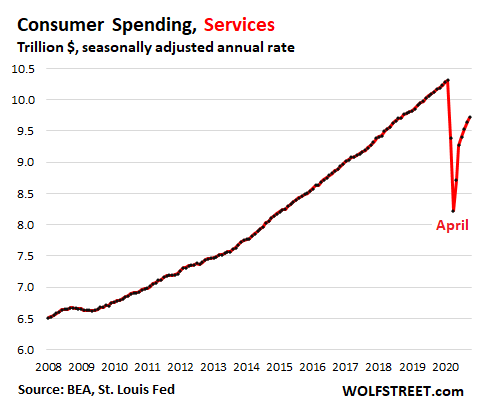
The shift from business spending to consumer spending.
Work-from-home and remote learning have had a big impact on consumer spending. Households upgraded their homes to accommodate the new work and study regime. They bought laptops like never before, they bought other electronic devices and network equipment. They bought desks and chairs and lamps. These were one-time expenditures to get set up, and they’re starting to fade out.
And they’re drinking coffee at home instead of drinking the free stuff at the office, and they’re eating at home instead of at the free cafeteria at work. They’re buying toilet paper and paper towels and snacks. And they’re using electricity at home all day. And on and on.
These outlays shifted spending from offices to households. In other words, some of the spending that used to show up under consumption by businesses is now showing up under consumption by households. This part of consumer spending doesn’t actually ad to the economy. It just shifts the money flow.
Credit-score algos got fooled by forbearance. Weirdest economy ever where no one knows what’s going on anymore. Read… No Payment, No Problem: In Rosy World of Forbearance, Official Delinquencies Plunge, Credit Scores of Delinquent Borrowers Jump
Enjoy reading WOLF STREET and want to support it? Using ad blockers – I totally get why – but want to support the site? You can donate. I appreciate it immensely. Click on the beer and iced-tea mug to find out how:
Would you like to be notified via email when WOLF STREET publishes a new article? Sign up here.
![]()
"low" - Google News
November 26, 2020 at 10:38AM
https://ift.tt/3m7Ibhp
The State of the American Consumer: Free Pandemic-Money Runs Low - WOLF STREET
"low" - Google News
https://ift.tt/2z1WHDx
Bagikan Berita Ini















0 Response to "The State of the American Consumer: Free Pandemic-Money Runs Low - WOLF STREET"
Post a Comment